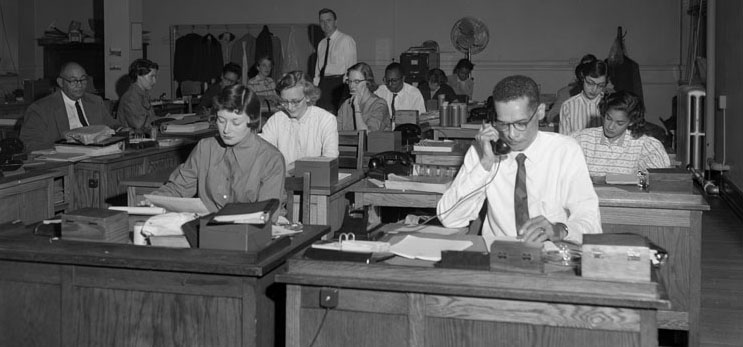We’ve been informed that we’re moving to a new office space — and this fact alone is making many, many people hyperventilate. Why? Oh, just the potential for the privacy crushing, morale diminishing, and the all-around “Big Brother”-ization of our workspace in the rumored, and dreaded, open workspace plan.
Is there anyone out there who actually likes the thought of an open workspace plan? Yes! Managers and other “big thinkers” who sternly believe making people have to stare at one another over lowered or invisible partitions will somehow increase collaboration, communication, productivity, and creativity. Yeah, no. What most of us think when we hear open workspace is, “I will never be able to have that telephone conversation with some idiot at the cable/doctor’s/spouse’s office.” Also, “Where will I put all of the stuff I’ve accumulated for the last twelve years?”
You may question that last one, but look around your office right now. Someone who’s worked in your office for the better part of two decades has a cubicle that could rival a flea market. You don’t want to know what’s in those cavernous desk drawers. All you know is that person could have a mishap midday and have an entire new set of clothing after lunch. And that’s what we are — creatures of habit and creatures of comfort. Of course we want to be able to communicate with others on our own terms — and not be forced into interaction under threat of some new agey idea of what collaboration is supposed to be — simply because we’re bumping into the next person from sheer lack of space, or because we’re all expected to whoop it up at a ping pong table, or an indoor Nerf basketball court. Or don’t we?
Aside from those Google aesthetics, basically, what has been shown is that the typical worker bee in many a corporation treasures two things: 1) privacy 2) space. These are two things that seem to be lost once management decides to “hipsterize” the workspace and put in things like long tables, “see-through collaborative spaces” and God forbid workbenches instead of desks. People start muttering things about “work pods” and “lean-in conference rooms” to the collective “huh?” of the typical workforce. Those of us used to our email interfaces and closed conference room doors haven’t even begun to consider how in the world one should actually act in a newfangled open workspace plan that believes a loud and often transient work environment will produce the kind of head down thought production that comes from being able to think deeply and resonantly about a problem. Good thing PricewaterhouseCoopers developed this handy graphic!
And personal accounts from the tales of the open workspace don’t encourage much faith. We’ve read article after article detailing just how awful open workspaces can be. The New Yorker says:
“…though open offices often fostered a symbolic sense of organizational mission, making employees feel like part of a more laid-back, innovative enterprise, they were damaging to the workers’ attention spans, productivity, creative thinking, and satisfaction. Compared with standard offices, employees experienced more uncontrolled interactions, higher levels of stress, and lower levels of concentration and motivation.”
Businessweek says:
“I worked out of there two weeks solid and got done half of what I would have accomplished at home,” says Carolyn Smuts, marketing director for NEAD App Development. “Even trying to answer e-mails there, somebody would hit me in the back of the head with a Nerf dart.” She started working from home more, where she didn’t have to share a desk “with people’s Stormtrooper action figures,” she says.
Even environmental psychology has determined that the disruptions and loss of privacy in the open workspace is hard to overcome:
Enclosed private offices clearly outperformed open-plan layouts in most aspects of IEQ (Indoor environmental quality), particularly in acoustics, privacy and the proxemics issues. Benefits of enhanced ‘ease of interaction’ were smaller than the penalties of increased noise level and decreased privacy resulting from open-plan office configuration.
And that’s just the tip of the iceberg, those who are brave enough to speak out, have discussed things like rampant colds and flu, smelly spaces from food and beverages left about, and workbench work areas piled high with books, papers, or other flotsam in an attempt to create some measure of barrier. So, the question remains, what is the ultimate point to all this?
But perhaps this thinking is wrongheaded. What do you think? What kind of office environment do you have and which do you think works the best; open, closed, or some other kind of workspace configuration? Tell us in the comments, and if you come across any great photos of workspaces, post those too.
Image: Wikimedia
